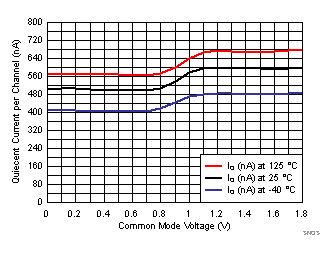JAJSD06E December 2016 – April 2018 TLV8541 , TLV8542 , TLV8544
UNLESS OTHERWISE NOTED, this document contains PRODUCTION DATA.
- 1 特長
- 2 アプリケーション
- 3 概要
- 4 改訂履歴
- 5 概要(続き)
- 6 Pin Configuration and Functions
- 7 Specifications
- 8 Detailed Description
- 9 Application and Implementation
- 10Power Supply Recommendations
- 11Layout
- 12デバイスおよびドキュメントのサポート
- 13メカニカル、パッケージ、および注文情報
8.4.2 Supply Current Changes Over Common Mode
Because of the ultra-low supply current, changes in common mode voltages cause a noticeable change in the supply current as the input stages transition through the transition region, as shown in Figure 30.
 Figure 30. Supply Current Change Over Common Mode at 1.8 V
Figure 30. Supply Current Change Over Common Mode at 1.8 V
For the lowest supply current operation, keep the input common mode range between V– and 1 V below V+.